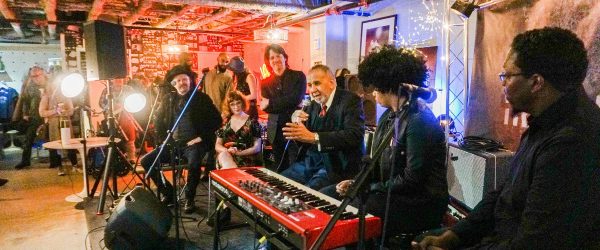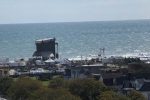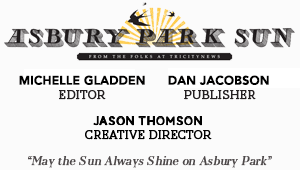Rev Gil Caldwell’s Reflection
Civil Rights Leader Hosts Sister Rosetta Tharpe Tribute In Celebration Of Community & Its Music History
City elder Rev. Gil Caldwell is most known as a civil rights activist; marching along Rev. Martin Luther King Jr who he first met in 1958, having been jailed for publicly supporting equal rights, and being turned away from a Pennsylvania hotel during his honeymoon with wife Grace.
The retired United Methodist Church minister, who has pastored congregations in Boston, New Haven, Brooklyn, Harlem, Chester, Pennsylvania, and Denver, moved to Asbury Park 10 years ago with wife of 60 years.
The octogenarian actively participated in the 1963 March on Washington, the 1964 Mississippi Freedom Summer, the 1965 Selma to Montgomery March, and the March in Boston protesting public school segregation, 1968 Poor People’s Campaign.
On Friday, Caldwell hosted a Sister Rosetta Tharpe tribute in support of KYDS – Konscious Youth Development Service, a nonprofit led by Mychal Mills and Rodney Salomon [above right] that promotes holistic choices in youth.
He sang the retooled gospel cut ‘I Woke Up This Morning With My Mind Stayed on Freedom’ with granddaughter Ashley. 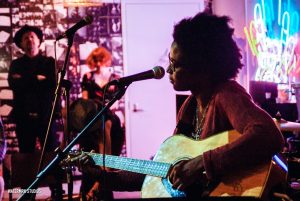
Presented by the Danny Clinch Transparent Gallery in conjunction with the New York Guitar Festival, Caldwell was joined by Second Baptist Pastor Samaj Vanzant [who celebrated his 2 year anniversary Sunday], Clinch, Des Spinks of Des and the Swagmatics, Rachel Ana Dobken, Jackson Pines, Jonathan Stamper, King Ramses, and the Who Dat Band.
The evening, captured by photographs by Michael Kravetsky of Watermrk Studios, was a celebration of Tharpes’ life as well as the local community and its musical history, organizers said.
Born March 20, 1915, Rosetta Tharpe was known as a pioneering gospel singer, songwriter and recording artist. She rose to national recognition in the 1930s and 1940s with her unique blend of spiritual lyrics set to rock and roll. During World War II, she was one of only 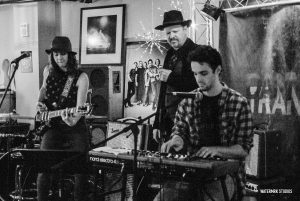 two black gospel acts to record V-Discs for American soldiers overseas. She suffered a stroke in 1970 and died October 9, 1973.
two black gospel acts to record V-Discs for American soldiers overseas. She suffered a stroke in 1970 and died October 9, 1973.
Below is Caldwell’s reflection on the night:
I spent the summer of 1998 in Jerusalem. We lived at Hebrew University on Mt. Scopus. The dormitory in which I lived was across the street from the Hadassah Medical Center. I did not realize until I left Jerusalem that summer that I was living across the street from the Marc Chagall Windows in the Medical Center.
My wife Grace and I live in the North Beach Condominiums three blocks away from the Danny Clinch Transparent Gallery. I had never visited the Gallery until my friend David Spelman had the idea of remembering and acknowledging the music of the African American Gospel singer-guitarist Sister Rosetta Tharpe.
On Friday night, with a host of other persons – some musicians and some who were not, we gathered with Danny Cinch and his spouse for an evening of music, dialogue, community building and much more. We gathered, to remember Sister Rosetta Tharpe, whose gender, race, and bisexual orientation were secondary to the music that was hers.
It is said of Chagall – Chagall’s genius transforms time and space. As I saw the photography of Danny Clinch for the first time of Tupac, Bruce and many more, I found myself thinking the photography of Danny Clinch, ‘transforms time and space’, because it captures the spirits of musicians whose music, moves us to realms, we experience, but so often, are indescribable.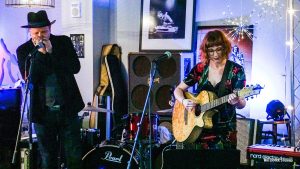
I remember the titles of Broadway plays that I have not seen. One title is The Loneliness of the Long Distance Runner; another I Am A Camera by John Van Druten. I Googled and found that the title was drawn from the first line of Christopher Isherwood’s novel Goodbye to Berlin – I am a camera with its shutter open, quite passive, recording, not thinking.
One reviewer of the play, described as a wag said of it – Me no Leica. I have never held a Leica camera in my hand, but I would say of what I saw, heard, felt and experienced at the Danny Clinch Transparent Gallery on Friday night as we experienced the music and life of Sister Rosetta Tharpe, I/we were in the presence of the ‘uniqueness of Asbury Park.’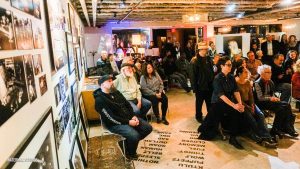
I have sought to describe that uniqueness and potential this way; “Asbury Park has a history of racial segregation, of riots some of us call rebellions; a history we must not deny. But, the way to correct and transform that history is for us to do over and over again, what we did on Friday night with and at the Gallery of Danny Clinch.”
The statue of racial segregationist, Mayor Bradley [the city’s founder], is not far away from the Danny Clinch Gallery, and it represents then but what happened at the gallery is the now and future of our little city by the sea. Amen and Amen.
Rev. Gil Caldwell
[Photos courtesy of Michael Kravetsky of Watermrk Studios]
——————————————————————————————————————
Follow the Asbury Park Sun on Facebook, Twitter and Instagram.
The Asbury Park Sun is affiliated with the triCityNews newspaper.

